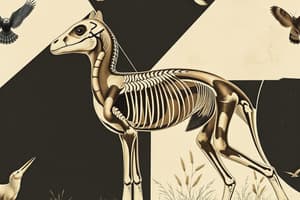Podcast
Questions and Answers
Which phylum exhibits a cellular level of organisation and includes flagellated choanocytes?
Which phylum exhibits a cellular level of organisation and includes flagellated choanocytes?
- Mollusca
- Chordata
- Porifera (correct)
- Echinodermata
What type of symmetry is exhibited by Echinodermata?
What type of symmetry is exhibited by Echinodermata?
- Radial symmetry (correct)
- Asymmetry
- Reflective symmetry
- Bilateral symmetry
Which of the following statements is NOT true regarding Chordata?
Which of the following statements is NOT true regarding Chordata?
- They have a dorsal hollow nerve cord.
- They possess a water vascular system. (correct)
- They always exhibit bilateral symmetry.
- They have a notochord.
Which type of skeleton is present in Mollusca?
Which type of skeleton is present in Mollusca?
What distinguishing feature do Hemichordata possess?
What distinguishing feature do Hemichordata possess?
Which of the following does NOT belong to the coelomate group?
Which of the following does NOT belong to the coelomate group?
What is a characteristic feature of the Arthropoda?
What is a characteristic feature of the Arthropoda?
Which of the following is NOT a feature related to the classification of animals?
Which of the following is NOT a feature related to the classification of animals?
What are the two basic body forms exhibited by cnidarians?
What are the two basic body forms exhibited by cnidarians?
What is the primary mode of reproduction for ctenophores?
What is the primary mode of reproduction for ctenophores?
Which characteristic is NOT associated with flatworms of the phylum Platyhelminthes?
Which characteristic is NOT associated with flatworms of the phylum Platyhelminthes?
Which feature aids in the locomotion of ctenophores?
Which feature aids in the locomotion of ctenophores?
What type of symmetry do sponges exhibit?
What type of symmetry do sponges exhibit?
Which of the following animals exhibit bilateral symmetry?
Which of the following animals exhibit bilateral symmetry?
What type of symmetry do ctenophores exhibit?
What type of symmetry do ctenophores exhibit?
What are animals with two embryonic layers called?
What are animals with two embryonic layers called?
How do polyps reproduce to form medusae in organisms that exhibit metagenesis?
How do polyps reproduce to form medusae in organisms that exhibit metagenesis?
What is the function of the mesoderm in triploblastic animals?
What is the function of the mesoderm in triploblastic animals?
Which of the following is an example of a cnidarian?
Which of the following is an example of a cnidarian?
Which animals are classified as diploblastic?
Which animals are classified as diploblastic?
What defines the tissue organization of ctenophores?
What defines the tissue organization of ctenophores?
What is the importance of the coelom in the classification of animals?
What is the importance of the coelom in the classification of animals?
Which of the following has a radial symmetry body plan?
Which of the following has a radial symmetry body plan?
Which layer is not present in diploblastic animals?
Which layer is not present in diploblastic animals?
What distinguishes reptiles from amphibians regarding their skin?
What distinguishes reptiles from amphibians regarding their skin?
Which characteristic is unique to Aves compared to other classes mentioned?
Which characteristic is unique to Aves compared to other classes mentioned?
Which of the following reptiles has a four-chambered heart?
Which of the following reptiles has a four-chambered heart?
What is the main method of reproduction for reptiles?
What is the main method of reproduction for reptiles?
What feature allows birds to maintain a constant body temperature?
What feature allows birds to maintain a constant body temperature?
Which of the following is an example of an amphibian?
Which of the following is an example of an amphibian?
What is one of the common locomotion characteristics of reptiles?
What is one of the common locomotion characteristics of reptiles?
Which structure in birds is modified for flight?
Which structure in birds is modified for flight?
What type of symmetry do molluscs exhibit?
What type of symmetry do molluscs exhibit?
Which of the following is NOT a characteristic of molluscs?
Which of the following is NOT a characteristic of molluscs?
What is the function of the radula in molluscs?
What is the function of the radula in molluscs?
What are the common examples of economically important insects from the Arthropoda phylum?
What are the common examples of economically important insects from the Arthropoda phylum?
Which of the following correctly describes the mantle in molluscs?
Which of the following correctly describes the mantle in molluscs?
What does it mean that molluscs are dioecious?
What does it mean that molluscs are dioecious?
Which of the following is considered a 'living fossil' in the context of arthropods?
Which of the following is considered a 'living fossil' in the context of arthropods?
What role does the mantle cavity serve in molluscs?
What role does the mantle cavity serve in molluscs?
Flashcards are hidden until you start studying
Study Notes
### Animal Kingdom Classification
- Porifera are multicellular animals with cellular level of organization and flagellated choanocytes.
- Coelenterata have tentacles and cnidoblasts.
- Sponges are mostly asymmetrical.
- Radial Symmetry exists in organisms where any plane passing through the central axis divides the organism into two identical halves.
- Bilateral Symmetry exists in organisms where the body can be divided into identical left and right halves in only one plane.
- Diploblastic Animals have cells arranged in two embryonic layers: an external ectoderm and an internal endoderm.
- Triploblastic Animals have a third germinal layer, mesoderm, between the ectoderm and endoderm.
- Coelom is a body cavity lined by mesoderm.
- Cnidarians have a skeleton composed of calcium carbonate.
- Cnidarians exhibit two basic body forms: polyp and medusa.
- Polyp is a sessile and cylindrical form, like Hydra.
- Medusa is an umbrella-shaped and free-swimming form, like Aurelia.
- Alternation of Generation (Metagenesis) exists in cnidarians exhibiting both polyp and medusa forms, where polyps produce medusae asexually, and medusae form polyps sexually.
- Ctenophores are exclusively marine, radially symmetrical, diploblastic organisms.
- Ctenophores have eight external rows of ciliated comb plates for locomotion.
- Bioluminescence, the property of emitting light, is common in ctenophores.
- Platyhelminthes have a dorso-ventrally flattened body and are called flatworms.
- Platyhelminthes are bilaterally symmetrical, triploblastic, and acoelomate animals.
- Arthropoda have a jointed exoskeleton of chitin, complete digestive system, and an open circulatory system.
- Mollusca are soft-bodied animals with a calcareous shell, unsegmented body, and a mantle cavity.
- Mollusca have a file-like rasping organ called a radula for feeding.
- Echinodermata have a water vascular system and radial symmetry.
- Hemichordata have a worm-like body with a proboscis, collar, and trunk.
- Chordata have a notochord, dorsal hollow nerve cord, gill slits, and limbs or fins.
- Amphibia are cold-blooded vertebrates that live in both aquatic and terrestrial environments.
- Reptilia are mostly terrestrial animals with dry and cornified skin, epidermal scales, or scutes.
- Reptilia have a three-chambered heart (except crocodiles which have a four-chambered heart).
- Aves (birds) are characterized by feathers, beaks, and wings.
- Aves have a four-chambered heart and are warm-blooded.
Studying That Suits You
Use AI to generate personalized quizzes and flashcards to suit your learning preferences.



